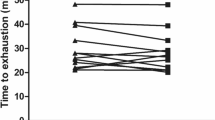Summary
Differentiated local ratings of perceived exertion from the legs and central ratings from the chest, and oxygen consumption, were determined during load carriage in seven young women. Subjects walked for 6 min at 3.22, 4.83, 6.44, or 8.05 km·h−1 carrying (1) no load, (2) a load equal to 7.5% of body weight (mean: 4.66 kg) or (3) a load equal to 15% of body weight (mean: 9.32 kg). Thus, each subject underwent 12 separate tests. The external loads were in the form of lead pellets carried in a plastic scuba belt worn around the waist. A differentiation threshold was found at 6.44 km·h−1 for the 0% and 7.5% loads and at 4.83 km·h−1 for the 15% load. At speeds below the threshold, the perception of exertion was similar in the legs, chest and overall. At higher speeds, exertion was perceived to be more intense in the legs than overall and less intense in the chest than overall, suggesting that the local legs signal was the dominant factor in shaping the overall sensation of exertion. The oxygen uptake was greater for the 15% load than for either the 0% or 7.5% loads, but was similar for the 0% and 7.5% loads. Findings suggested a critical weight limit for external loads that could be transported without increasing the metabolic cost beyond that required to move the body weight alone. This limit fell between 7.5% and 15% of the body weight. When oxygen uptake was expressed per kg of total weight transported, there was no loss of metabolic efficiency while carrying loads up to 15% of the body weight.
Similar content being viewed by others
References
American College of Sports Medicine (1978) Policy statement regarding the use of human subjects and informed consent. Med Sci Sports 10: 13
Borg G (1970) Perceived exertion as an indicator of somatic stress. Scand J Rehabil Med 2: 92–98
Cafarelli E (1977) Peripheral and central inputs to the effort sense during cycling exercise. Eur J Appl Physiol 37: 181–189
Cafarelli E, Cain W, Stevens J (1977) Effort of dynamic exercise: Influence of load, duration and task. Ergonomics 20: 147–158
Cathcart E, Richardson D, Campbell W (1923) Army hygiene advisory committee report No. 3 on the maximum load to be carried by the soldier. JR Army Med Corps 41: 161–178
Cavagna G, Saibene F, Margaria R (1963) External work in walking. J Appl Physiol 18: 1–9
Consolazio C, Johnson R, Pecora L (1963) Physiological measurements of metabolic functions in man. McGraw-Hill, New York, pp 6–8
Ekblom B, Goldbarg A (1971) The influence of physical training and other factors on the subjective rating of perceived exertion. Acta Physiol Scand 83: 399–406
Ekblom B, Lövgren O, Alderin M, Fridström M, SÄtterström G (1975) Effect of short-term physical training on patients with rheumatoid arthritis: I. Scand J Rheumatol 4: 80–86
Gamberale F (1972) Perceived exertion, heart rate, oxygen uptake, and blood lactate in different work operations. Ergonomics 15: 545–554
Goldman R, Iampietro P (1962) Energy cost of load carriage. J Appl Physiol 17: 675–676
Horstman D, Morgan W, Cymerman A, Stokes J (1979) Perception of effort during constant work to self-imposed maximum. Percept Mot Skills 48: 1111–1126
Kamon E, Belding H (1971) The physiological cost of carrying loads in temperate and hot environments. Hum Factors 13: 153–161
Kamon E, Metz K, Pandolf K (1973) Climbing and cycling with additional weights on the extremities. J Appl Physiol 35: 367–370
Kinsman R, Weiser P (1976) Subjective symptomatology during work and fatigue. In: Simmonson E, Weiser P (eds) Psychological aspects and physiological correlates of work and fatigue. Thomas, Springfield IL, pp 336–405
Malhotra M, Ramaswamy S, Ray S (1962) Influence of body weight on energy expenditure. J Appl Physiol 17: 433–435
McDonald I (1961) Statistical studies of recorded energy expenditure of man. Nutr Abstr Rev 31: 739–762
Noble B, Metz K, Pandolf K, Bell C, Cafarelli E, Sime W (1973) Perceived exertion during walking and running: II. Med Sci Sports 5: 116–120
Pandolf K, Burse R, Goldman R (1975) Differentiated ratings of perceived exertion during conditioning of older individuals using leg-weight loading. Percept Mot Skills 40: 563–574
Pandolf K (1978) Influence of local and central factors in dominating rated perceived exertion during physical work. Percept Mot Skills 46: 683–698
Pimentai N, Pandolf K (1979) Energy expenditure while standing or walking slowly uphill or downhill with loads. Ergonomics 22: 963–973
Robertson R, Gillespie R, McCarthy J, Rose K (1979a) Differentiated perceptions of exertion: Part I. Mode of integration of regional signals. Percept Mot Skills 49: 683–689
Robertson R, Gillespie R, McCarthy J, Rose K (1979b) Differentiated perceptions of exertion: Part II. Relationship to local and central physiological responses. Percept Mot Skills 49: 691–697
Skinner J, Hutsler R, Bergsteinova V, Buskirk E (1973) Perception of effort during different types of exercise and under different environmental conditions. Med Sci Sports 5: 110–115
Soule R, Goldman R (1969) Energy cost of loads carried on the head, hands, or feet. J Appl Physiol 27: 687–690
Soule R, Pandolf K, Goldman R (1978) Energy expenditure of heavy load carriage. Ergonomics 21: 373–381
Strydom N, Van Graan C, Morrison J, Van Joen J, Heyns A (1968) The influences of body weight on the energy expenditure of men walking on a treadmill and climbing steps. Arbeitsphysiologie 25: 191–197
Weiser R, Stamper D (1977) Psychophysiological interactions leading to increased effort, leg fatigue, and respiratory distress during prolonged strenuous bicycle riding. In: Borg G (ed) Physical work and effort. Pergamon, Oxford, pp 401–416
Author information
Authors and Affiliations
Rights and permissions
About this article
Cite this article
Robertson, R.J., Caspersen, C.J., Allison, T.G. et al. Differentiated perceptions of exertion and energy cost of young women while carrying loads. Europ. J. Appl. Physiol. 49, 69–78 (1982). https://doi.org/10.1007/BF00428965
Accepted:
Issue Date:
DOI: https://doi.org/10.1007/BF00428965




